No evidence of attenuation of placental insulin-stimulated Akt phosphorylation and amino acid transport in maternal obesity and gestational diabetes mellitus
- PMID: 31573844
- PMCID: PMC6962503
- DOI: 10.1152/ajpendo.00196.2019
No evidence of attenuation of placental insulin-stimulated Akt phosphorylation and amino acid transport in maternal obesity and gestational diabetes mellitus
Abstract
Pregnancies complicated by obesity and/or gestational diabetes (GDM) are associated with peripheral insulin resistance; however, the insulin responsiveness of the placenta in these pregnancy complications remains largely unknown. We tested the hypothesis that primary human trophoblast cells and placental villous explants will be insulin responsive, characterized by amino acid transport, Akt and Erk activity with maternal obesity, and/or GDM. We evaluated term placentas from women with normal body mass index (BMI) (normal; n = 15), obesity (OB; n = 11), normal BMI with GDM (N-GDM; n = 11), and obesity with GDM (OB-GDM; n = 11). In a subgroup, primary human trophoblast cells (PHT) were isolated, and in an independent subgroup placental villous explants were exposed to varying concentrations of insulin. Amino acid transport capacity and insulin signaling activity were determined. Insulin significantly increased amino acid transport activity to a similar degree in PHT cells isolated from normal (+21%), N-GDM (+38%), OB (+37%), and OB-GDM (+35%) pregnancies. Insulin increased Akt and Erk phosphorylation in PHT cells (3-fold) and in villous explants (2-fold) in all groups to a similar degree. In contrast to the peripheral maternal insulin resistance commonly associated with obesity and/or GDM, we found that the placenta is insulin sensitive in these pregnancy complications. We suggest that elevated maternal insulin levels in pregnancies complicated by obesity and/or GDM promote critical placental functions, including amino acid transport. Insulin-stimulated placental nutrient delivery may contribute to the increased risk of fetal overgrowth and adiposity in these pregnancies. Moreover, our findings may inform efforts to optimize insulin regimens for women with GDM.
Keywords: human; insulin sensitivity; placental transport; pregnancy; syncytiotrophoblast.
Conflict of interest statement
No conflicts of interest, financial or otherwise, are declared by the authors.
Figures



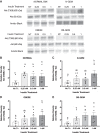
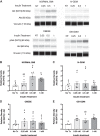
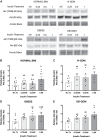
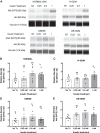
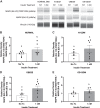
Similar articles
-
Apelin is a novel regulator of human trophoblast amino acid transport.Am J Physiol Endocrinol Metab. 2019 May 1;316(5):E810-E816. doi: 10.1152/ajpendo.00012.2019. Epub 2019 Mar 5. Am J Physiol Endocrinol Metab. 2019. PMID: 30835509 Free PMC article.
-
Lipopolysaccharide and double stranded viral RNA mediate insulin resistance and increase system a amino acid transport in human trophoblast cells in vitro.Placenta. 2017 Mar;51:18-27. doi: 10.1016/j.placenta.2017.01.124. Epub 2017 Jan 21. Placenta. 2017. PMID: 28292465
-
Human placental exosomes in gestational diabetes mellitus carry a specific set of miRNAs associated with skeletal muscle insulin sensitivity.Clin Sci (Lond). 2018 Nov 29;132(22):2451-2467. doi: 10.1042/CS20180487. Print 2018 Nov 30. Clin Sci (Lond). 2018. PMID: 30254065
-
Expression of nutrient transporters in placentas affected by gestational diabetes: role of leptin.Front Endocrinol (Lausanne). 2023 Jul 11;14:1172831. doi: 10.3389/fendo.2023.1172831. eCollection 2023. Front Endocrinol (Lausanne). 2023. PMID: 37497352 Free PMC article. Review.
-
Role of Insulin in Placental Transport of Nutrients in Gestational Diabetes Mellitus.Ann Nutr Metab. 2017;70(1):16-25. doi: 10.1159/000455904. Epub 2017 Jan 21. Ann Nutr Metab. 2017. PMID: 28110332 Review.
Cited by
-
Maternal Plasma Choline Levels Are Positively Correlated with Maternal and Placental Phospholipid-DHA Content in Females with Obesity Who Receive DHA Supplementation.J Nutr. 2025 Mar;155(3):880-889. doi: 10.1016/j.tjnut.2024.12.030. Epub 2024 Dec 30. J Nutr. 2025. PMID: 39742970
-
Association of gestational and childhood circulating C-peptide concentrations in the hyperglycemia and adverse pregnancy outcomes follow-up study.Diabetes Res Clin Pract. 2025 Feb;220:111967. doi: 10.1016/j.diabres.2024.111967. Epub 2024 Dec 21. Diabetes Res Clin Pract. 2025. PMID: 39716665
-
The human placenta and its role in reproductive outcomes revisited.Physiol Rev. 2025 Oct 1;105(4):2305-2376. doi: 10.1152/physrev.00039.2024. Epub 2025 Jun 11. Physiol Rev. 2025. PMID: 40497429 Review.
-
Effect of type 2 diabetes mellitus on placental expression and activity of nutrient transporters and their association with birth weight and neonatal adiposity.Mol Cell Endocrinol. 2021 Jul 15;532:111319. doi: 10.1016/j.mce.2021.111319. Epub 2021 May 12. Mol Cell Endocrinol. 2021. PMID: 33989714 Free PMC article. Clinical Trial.
-
Epigenetic modifications of placenta in women with gestational diabetes mellitus and their offspring.World J Diabetes. 2024 Mar 15;15(3):378-391. doi: 10.4239/wjd.v15.i3.378. World J Diabetes. 2024. PMID: 38591094 Free PMC article. Review.
References
Publication types
MeSH terms
Substances
Grants and funding
LinkOut - more resources
Full Text Sources
Other Literature Sources
Medical
Miscellaneous

